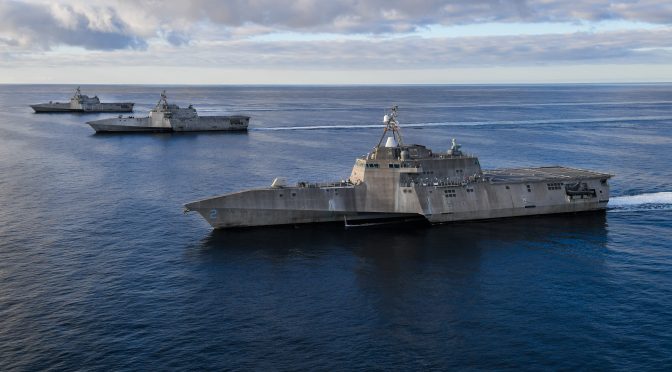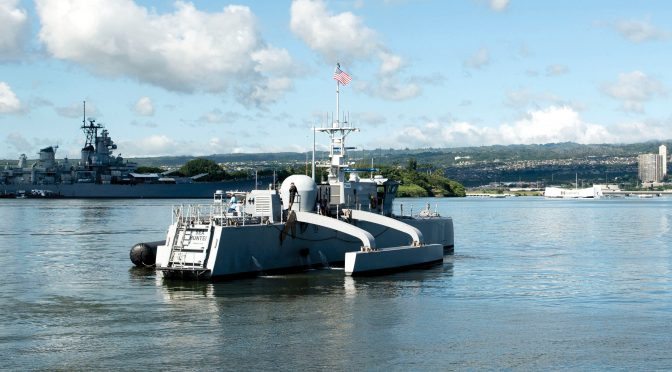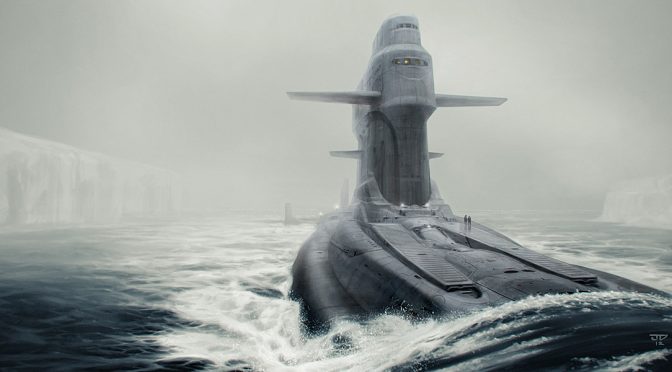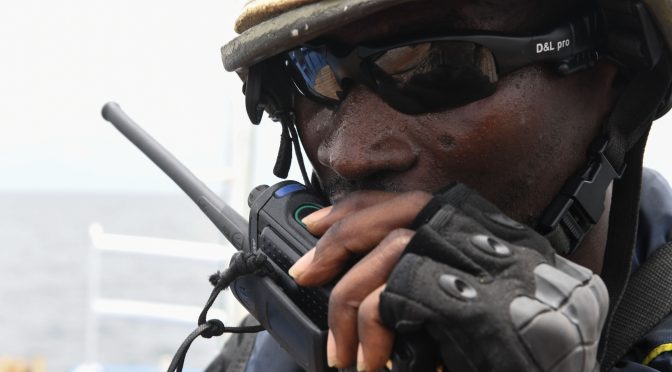Unmanned Maritime Systems Topic Week
By Dustin League and LCDR Daniel Justice
Introduction
The U.S. Navy faces a future where large portions of its fleet will be composed of non-traditional assets. Specifically, unmanned systems comprise a significant portion of the CNO’s “key platforms and payloads” which the Navy seeks to acquire.1 That direction from the top is further born out in the Navy’s most recent shipbuilding plan which includes 10 large unmanned surface vessels and 191 unmanned undersea vehicles of various sizes. These numbers contrast with the total of 55 “battle force ships” planned to be built over the same period.2 Tonnage obviously also plays a role in this type of comparison, but by sheer numbers the Navy is moving toward unmanned vice manned platforms. The Navy must think past the engineering hurdles and determine how to effectively employ these new assets. To do so, we propose that the Navy revisit history and revitalize the complex learning system it used to exploit an earlier set of new capabilities prior to World War II. Specifically, we call for the Navy to accelerating standing up a dedicated experimental squadron with the purpose of exploring advanced tactics for employing unmanned systems in a series of tactically challenging, objective-based exercises.
The Precedent
Unmanned systems create new tactical and operational opportunities for the U.S. Navy and adversaries. But this is not the first time in the Navy’s history where technological advances have called into question old operating patterns. The Navy has come through similar transitions, with varying levels of success. Sometimes the Navy stayed ahead of transitions, taking advantage of technology before war (effectively employing naval air power) and sometimes it learned more slowly and at greater cost (for example, night-time battles in the Solomon Islands). What allowed the Navy to successfully adapt in these circumstances – whether fast or slow – was, as Trent Hone discusses in his book Learning War, its complex learning system.
Hone identifies the basic four-part pattern the Navy employed between 1898-1945 to adapt its tactics and doctrine and incorporate a host of new technologies:
- Identify the problem
- Establish constraints
- Encourage parallel experimentation
- Exploit the best-fitting solution3
These components formed a complex system that allowed the Navy to transform after the Spanish-American War, provide support to the British during World War I, and eventually defeat the Imperial Japanese Navy in World War II. These four components were, to various degrees, embodied by different organizations within the Navy. The Naval War College was a key component in this structure and utilized war games to explore tactical innovations. However, the Navy’s success relied on operationalizing the concepts through actual fleet maneuvers. It accomplished this through various means like the Atlantic Fleet Torpedo Flotilla under Sims and Knox and the Fleet Problems of the 1920s and 1930s. Today, as it grapples with UxV employment, the Navy first needs to ensure it still functions as a complex learning system similar to what its predecessors designed.
Identify the problem. The Navy is introducing a host of new unmanned systems to the fleet, but what is the problem? Perhaps the Navy doesn’t know how to best use all these new systems and employing them poorly imposes opportunity costs. Should swarms of UxVs be sent separately and autonomously ahead of a battle fleet? Would they be better used as autonomous “wingmen” to manned systems? How do we get the best robot bang for our AI buck? Money spent on deploying a highly capable UxV in a way which utilizes only a fraction of its capability is money that could be better spent on systems the Navy knows how to use to full effect.
Establish constraints. Unmanned systems are not magic. They have significant limitations, not all of which are yet understood. In the undersea realm particularly, energy storage and sensing will continue to impose far greater restrictions on UUVs than have been seen on UAVs. Other constraints will emerge over time as more experience is gained operating with these systems. Hard limits on autonomous behaviors, on clandestine recovery, or on communications may yet be discovered and which may eventually drive system CONOPs. Rules of Engagement and associated human-in-the-loop requirements also pose considerable constraints. Efforts will continue to overcome these issues, but solving any limitation will be less important than understanding the constraints. Understanding and characterizing constraints allows for the simulation of a system—a method the Navy has long embraced.
Encourage parallel experimentation. To determine how to use a new system, the Navy has to try and be willing to fail. Hone describes the development of long-range gunnery techniques as an example of parallel experimentation in a safe-to-fail environment.4 In that process, the Navy allowed the ships and squadrons of its fleet to trial new systems, technologies, and tactics without forcing the entire Navy to adopt a single solution too early. This flexible approach, where systems were incorporated into the existing architecture of combatants, prevented the Navy from making a selection too early in the development process. It also prevented a “race to the bottom” solution where every ship was forced to implement the lowest common denominator option. UxV experimentation should utilize the same methodology and safe-to-fail mentality.
Exploit the best-fitting solution. Fleet-wide adoption of solutions present its own challenge. Here the Navy’s learning system of the early 20th century can be augmented by more recent research on innovation and adaptation. Since the mid-1980s academics studying business innovation have understood that there is a distinction between “invention,” the act of coming up with a new idea, and “innovation,” the act of causing a new idea to be widely accepted in an organization.5 It is not a given that a large, complex organization will naturally pick up and start using the best solutions to its problems, even after they are identified. Deliberate effort needs to be taken on the part of leadership to ensure the organization adopts the new methods.
In The Innovator’s Way, Peter Denning and Robert Dunham compiled and analyzed the results of two decades of innovation research. Their work helps to understand the challenges the Navy will face in exploiting new solutions—what Denning and Dunham refer to as “Third Adoption” or “Sustainment.”6 First, large organizations can be resistant to new approaches.7 This phenomenon has been recognized in naval circles for some time, often referred to as the “frozen middle.”8 Denning recommends leaders overcome resistance by adopting allies inside the network they seek to influence and continually reshaping the narrative about the new tactics to improve their “innovation story.”9 Second, once new ideas are spread through the Navy, leadership will have to ensure they do not drop out of use before they are truly obsolete. To ensure this, Navy leadership must ensure UxV CONOPs are enabled and supported.10 This entails continued training, material support, and continued value communication.11
Adopting the Process for Unmanned Systems
Many of the pieces required to replicate the success of the early 1900s are already understood by today’s Navy leaders. The Navy has already recognized the need for a squadron devoted to exploring how new systems are best employed. Vice Admiral Richard Brown, Commander, Naval Surface Forces and Naval Surface Forces Pacific, has called out the need for an experimental squadron to test new technologies, systems, and CONOPs for surface warfare. His assessment that the Navy needs “aggressive experimentation” is spot on.12 The Navy needs to move from saying the right things to committing to an actual organization to implement the modern-day equivalent of Hone’s parallel experimentation using real-world forces.
The best-fit platform for an experimental squadron will be one that is good enough, not perfect. A perfect experimental squadron will never exist. It is easy to imagine an experimental squadron made up of all our best and most capable new systems. One should also be able to imagine the horrendous cost, not only in terms of paying for and maintaining those systems but also the opportunity cost. A destroyer assigned to an experimental squadron is one that can’t be supporting the Navy’s vital needs elsewhere, imposing more strain on already thin force structure. So, rather than the ideal, the Navy must work with “good-enough.”
The Littoral Combat Ship was never meant to be the ideal solution to any kind of naval warfare, it was meant to be a good-enough solution to several. It is apt then, that its very organization provides a good-enough solution to a Navy problem it was never explicitly designed to fit all. In 2016, responding to a host of issues, the LCS program was reorganized to include a test division within LCSRON 1. The first four LCS’s grouped together with a mandate to “focus solely on testing hardware, software and concepts of operations to support bringing new mission module equipment into the fleet.”13 This is the mission description of an experimental squadron—only it is a single division of a single unit class of dubiously capable ships. Still, it is good enough.
The employment of an experimental squadron provides the Navy with a test-bed for unmanned systems. Designed with mission adaptability in mind, the LCS should serve as an excellent platform for employing a wide range of unmanned systems across a variety of missions. Echoes of this approach, using small ships in conjunction with unmanned systems to test and develop tactics and techniques, can been seen in previous Navy efforts such as the Center for Asymmetric Warfare’s (CAW) efforts with the small patrol craft CSW-1.14 It is also feasible to combine this suggested LCSRON test squadron approach to the “concept development hubs” whose formation is directed in the second iteration of the Chief of Naval Operations’ Design for Maintaining Maritime Superiority.15 Having multiple ships dedicated to employing UxVs to solve common operational challenges promotes creative and competitive problem solving. Having a single unit (such as UUVRON) devoted to the logistic and engineering challenges of the family of unmanned systems makes sense, but exploring new tactics is a task better suited to a diversified organization. The four-ship experimental squadron should be seen not as the sole solution for perfecting UxV tactics, it can only serve as a hotbed to be backed by follow-on fleet experimentation. The entire fleet should be involved. We add two precepts for how the Navy can best employ this learning system as embodied by the experimental squadron.
Objectives-based exercises. The test squadron must focus on real experimentation, which brings with it the opportunity for failure. The Navy must accept the likelihood that many of their experiments will fail. Deriving lessons from failure through hotwashes and critiques is not a new concept in the Navy. Tightly-scripted evolutions which showcase the ability of a system to complete specified tasks provide minimal insight, especially when they are devoid of capable opposition forces. They are demonstrations, not real exercises. Experiments and exercises provide more insight in failure than success—failure illuminates new constraints; success delivers only the expected. Technical demonstrations prove viability and build operator confidence in the system, but they do not provide tactical insight or shape doctrine. That kind of insight comes from allowing the fleet to experiment in pursuit of operational and tactical objectives.
This concept was seen in the early 20th century with the development of The Combat Air Patrol (CAP), first employed by Ernest King as part of Fleet Problem XII.[16] It was not employed as part of an exercise which detailed a flight schedule for CAP aircraft—a technical demonstration of capability, instead it was employed because King saw a need to protect his carrier while he sought to meet the tactical and operational demands of the Problem. These kinds of exercises, where commanders are given broader objectives to achieve rather than specific evolutions to perform will elicit real insight and experimentation. The problems must be challenging, the kind where today’s tactics, doctrine, and systems are allowed to fail. Only when old tools fail will commanders innovate new, successful methods.
Levels of reality. Putting ships to sea is expensive, turning on computers is cheap, and assigning problems to students is even cheaper. Even a relatively cheap experimental squadron like the one proposed here cannot test every new tactical theory or CONOP. A hierarchy of experimentation should be constructed which allows for the most promising ideas to bubble up to the experimental squadron for real-world vetting.
At the base level the Navy needs to draw on the tactical acumen and creativity of its line officers. The Naval War College and Postgraduate School provide excellent venues for this exploitation. Consideration should also be given to expanding this exploratory phase to civilian institutions with strong security studies programs. The War College has a storied history of employing wargames in developing new tactics and doctrine. Students can be assigned problems to research and design tactical and operational solutions. These solutions can then be wargamed—using constraints derived from real-world operations—to sort the wheat from the chaff. The goal should not be to find one solution but a set of solutions worthy of further exploration in the real world.
Wargames are an excellent venue for testing operational concepts, but they require time and manpower. The number of them that can be run—even by incorporating organizations beyond the traditional—will always be lower than the demand. Computer simulation, by contrast, requires much less time. There is considerable resource demand in building the models for simulation, but running them consumes far less time than human wargames.17 This allows for testing hundreds or thousands of cases stochastically with varying parameters. The fidelity of these models can also vary, with pure software at the lowest level and hardware-in-the-loop models incorporating the actual, physical systems. Hardware-in-the-loop testing can reveal the limitations in a CONOP which might not be apparent during a wargame due to insufficiently granular constraints.
At the highest level of fidelity the experimental squadron can test CONOPs using real hardware in its actual operating environment. The fidelity of computer simulations and even wargames will never match the real world. Ships at sea putting UxVs through stressing—both engineering and tactically—evolutions will expose flaws and opportunities that the best models will miss. Such exercises will generate the feedback needed to revise the constraints of the wargames and computer simulations, ensuring that the next batch of CONOPs to percolate up to the squadron are more robust and ready for primetime.
The experimental squadron itself should employ various degrees of simulation. The tenure of William Sims as commander of the Atlantic Torpedo Flotilla provides the model for how to employ the squadron.18 Sims created tactical problems for his ships, utilized conferences and games to conceptualize new approaches and tactics, and then used the ships of his command to play them out at sea. The ships of LCSRON 1’s development division, enhanced with a family of UxV systems, should be employed in the same manner. The LCS’s can employ onboard trainers to conduct software- and hardware-in-the-loop simulations, the ships’ captains can game new tactics, and they can conduct live exercises at sea. At times the LCS’s themselves can play the roles of simulated combatants of other types (destroyers, cruisers, carriers19) but there should also be opportunities to train with the fleet.
Disseminate knowledge. After the proposed squadron develops new tactics and doctrines, there remains a final challenge, to disseminate them to the fleet and encourage their adoption. A brilliant new tactic is useless when it only sits on the page of a never-read exercise after action report or in a rarely consulted tactics publication. It must be actually adopted and practiced by units and commands during real operations.
Any ship in the fleet can develop new tactics or new operational concepts. The benefits of institutionalizing learning systems are not only their ability to generate new concepts, but to transform them into useful doctrine. The Combat Information Center revolutionized naval warfare, enabling the U.S. Navy to process the information available from new sensors (primarily radar) and act on it faster than their WWII opponents. Officers like Lieutenant Commander J. C. Wylie responded to the demands of combat with innovation, making do with the systems at hand—jury-rigged as necessary—by creating new methods.20 Their innovations helped deliver American victories throughout the Pacific, but only because the Navy exploited and shared their discoveries by drafting new doctrine and standing up schools to train its officers in the new methods.
Tactics, shared, become doctrine. Doctrine provides the fleet with a shared bedrock of knowledge. As Captain (Ret.) Wayne Hughes says, “Tactical doctrine is the standard operating procedure that the creative commander adapts to the exigencies of battle.”21 That common ground is an enabling constraint which allows commanders to understand what choices their subordinates are likely to make during combat. But doctrine represents only one form of knowledge dissemination, perhaps not the most important, when exploring new systems and technologies. Knowledge must be effectively shared horizontally and vertically—information must also flow through the “levels of reality” discussed above. This allows the creation of feedback loops, another important feature of a complex learning system. Shortening the loop from CONOPs ideation, to fleet testing, and back to the “drawing board” will limit the loss of critical information and drive an upward spiral. Slow, cumbersome chains of communication between the fleet and its supporting organizations will drive frustration within the process and promote the stillbirth of promising concepts.
Conclusion
Unmanned systems tantalize with the possibility of revolutionizing naval warfare. They have the potential to extend the fleet’s reach further than ever before. They may allow the Navy to hold targets at risk despite our adversaries’ best attempts to erect anti-access/area-denial defense systems while putting far fewer Sailors in harm’s way. Failing to develop the tactics and doctrine which best exploits that potential will risk leaving critical capabilities off the table. Exploiting unmanned systems to the hilt requires the Navy to look back in history to the last time it faced such challenges both in terms of incorporating new technology and facing great power maritime competition – the interwar and WWII periods. The Navy created within itself a complex, adaptive learning organization that was able to bring radar, airpower, combat information, and submarines into battle across the Pacific Ocean against a powerful adversary and win.
We have proposed one method for re-creating that success. The Naval War College, and other institutions, should challenge students to formulate new tactics and CONOPs for employing unmanned systems. The Navy and its industry partners should use modeling and simulation to trial those tactics. But perhaps most importantly, a dedicated experimental squadron hosting the whole family of unmanned vehicles should put the most promising tactics into action in live, challenging, objective-based exercises with the results fed back to restart the loop. Only the best ideas will survive these trials and deliver on the full promise of unmanned systems to tomorrow’s fleet.
Dustin League is a Senior Military Operations Analyst at Systems Planning and Analysis, Inc. and a former U.S. Navy Submarine Warfare Officer. The views and opinions expressed here are his own and do not reflect those of SPA, Inc.
LCDR Dan Justice is a U.S. Navy Foreign Affairs Officer and former Submarine Warfare Officer. The views and opinions expressed here are his own and do not reflect those of the U.S. Navy.
References
[1] (Richardson 2018)
[2] (Navy 2019)
[3] (Hone 2018, 338)
[4] (Hone 2018, 55-91)
[5] (Denning and Dunham 2010, xiv)
[6] (Denning and Dunham 2010, 187)
[7] (Denning and Dunham 2010, 200)
[8] (Knudson 2016)
[9] (Denning and Dunham 2010, 200)
[10] (Denning and Dunham 2010, 205)
[11] (Denning and Dunham 2010, 209)
[12] (Eckstein, Navy Pursuing ‘Surface Development Squadron’ to Experiment with Zumwalt DDGs, Unmanned Ships 2019)
[13] (Eckstein, Littoral Combat Ship Program Vastly Different a Year Into Major Organizational, Operational Overhaul 2017)
[14] (Cawcontacts 2010)
[15] (Richardson 2018)
[16] (Hone 2018, 333)
[17] For an excellent description of the benefits and difficulties of iterative wargaming see James Lacy’s article “How does the next Great Power Conflict Play Out? Lessons from a Wargame” https://warontherocks.com/2019/04/how-does-the-next-great-power-conflict-play-out-lessons-from-a-wargame/ (Lacy 2019)
[18] (Hone 2018, 114-117)
[19] It would be exceedingly difficult for an LCS to play a mock submarine.
[20] (Hattendorf 1967)
[21] (Hughes and Girrier 2018)
Bibliography
Denning, Peter, and Robert Dunham. The Innovator’s Way: Essential Practices for Successful Innovation. MIT Press, 2010.
Eckstein, Megan. “Littoral Combat Ship Program Vastly Different a Year Into Major Organizational, Operational Overhaul.” USNI News. September 6, 2017. https://news.usni.org/2017/09/06/littoral-combat-ship-program-vastly-different-year-major-organizational-operational-overhaul (accessed April 9, 2019).
“Navy Pursuing ‘Surface Development Squadron’ to Experiment with Zumwalt DDGs, Unmanned Ships.” USNI News. January 28, 2019. https://news.usni.org/2019/01/28/navy-still-pursuing-surface-development-squadron-experiment-zumwalt-ddgs-unmanned-ships.
Hattendorf, John B. “Introduction.” In Military Strategy: A General Theory of Power Control, by J.C. Wylie. Annapolis: Naval Institute Press, 1967.
Home, Trent. Learning War: The Fighting Doctrine of the U.S. Navy, 1898-1945. Annapolis: Naval Institute Press, 2018.
Hughes, Wayne Jr., and Robert P. Girrier. Fleet Tactics and Naval Operations (Third Edition). Annapolis: Naval Institute Press, 2018.
Knudson, Jason. “The Frozen Middle and the CRIC.” USNI Blog. February 2016. https://blog.usni.org/posts/2016/02/19/the-frozen-middle-and-the-cric (accessed April 2019).
Featured Image: PACIFIC OCEAN (Feb. 27, 2019) The Independence variant littoral combat ships USS Independence (LCS 2), left, USS Manchester (LCS 14), and USS Tulsa (LCS 16) are underway in formation in the eastern Pacific. (U.S. Navy photo by Chief Mass Communication Specialist Shannon Renfroe/Released)





